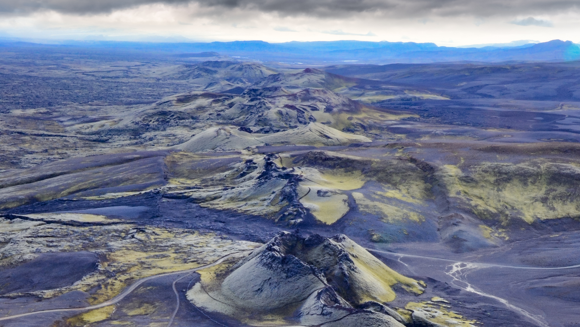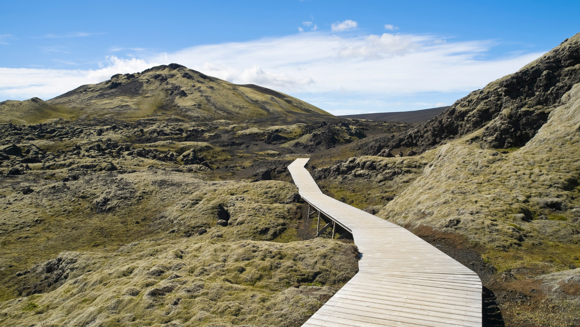Stunning Lakagigar Crater Row

The Lakagígar craters, also known as Laki, are another absolutely incredible feature of Iceland’s natural beauty. 130 giant craters stretch along some 27 kilometres located to the southwest of Vatnajökull National Park. The row of craters exists as part of a much larger lava field, covered with unique and colourful mosses. Whether it’s exploring the visitor trails, learning about the violent eruptions in the past or camping on the nearby grounds, the crater row is certainly something to behold.
The Laki Eruptions
The eruptions that formed this enormous natural attraction were one of the most influential events in the country’s history, with repercussions felt around the globe at the time. On the 8th of June 1783, a fissure opened in the southwest of the Vatnajökull National Park. Lava flowed over the ground, destroying several farms in the early stages of the eruption. Further lava productions flowed across both banks of the River Hverfisfljót, destroying further crops and livestock.

In addition to the lava flows, a dense ash cloud was produced which sat above the country. In fact, ports were made too unsafe to access in Iceland and Europe, halting several essential trade routes. The climate was ravaged by the very same eruption, causing issues for even further crop yields and livestock farmers all over the country. After 8 months, the eruption was felt to cease, leaving a tidal wave of damage in its wake.
The effects of the eruption were not only felt in Europe but also in Asia and Africa, including famine in Egypt. France also felt notable impacts, thanks to large depletions in grain harvests and therefore bread production, leading to the stirring of the great French Revolution.
While examining the majesty of the Laki crater row, it’s not just the impacts on global history that you should think of. The devastation that reigned over the island due to the eruption was immense, killing ¼ of all Icelanders either directly or as a result of food shortages.
Things to Do at Lakagígar
The Lakagígar crater row formed by this fissure eruption makes for a fantastic stop on your road trip through Vatnajökull National Park, or the East of Iceland in general. The roads through the mountains are only open when the weather is good enough in summer, typically from the beginning of June.
-
Walking Trails: The Laki craters are a breathtaking sight, especially well-received when you’ve earned them after a wander around the lava fields. On the site, there is a visitor trail with lots of information about the eruptions that created these giant craters. Footpaths at the base take you inside 2 of the most accessible craters, as well as a fascinating lava tunnel nearby, offering new and interesting ways to explore the landscape.
-
Photography: As you can see from the dramatic photos within this blog, opportunities to take incredible photos are endless. With a drone, you can capture breathtaking footage from above the rolling craters. Even better, if you can climb to a higher peak among the craters, a clear day will grant you views of tall mountains and glaciers in the distance.
-
Mosses: This area of the national park above all areas in Iceland is where mosses are most successful. In aerial photography, the areas of green standing out against the darker lava-plain soil are where mosses are growing. Their very small leaves absorb all the precipitation and nutrients needed, with no roots in the earth below. For this reason, stepping on moss will kill it forever, and no other moss will grow in its place. It’s therefore imperative to take care and stick to footpaths when visiting the craters at Laki.

How to Get to Lakagígar Craters
The Laki craters are only accessible by car, like many areas of central Iceland, and it's best to choose a 4x4 for these tricky mountain roads. Potholes, gravel tracks and even some surprise river crossings could all feature on the journey between the main road and the crater row. For this reason, you should stick to roads that are marked on maps and never attempt to drive off-road.
If you are following Route 1, you’ll need to leave the main road by the Hunkubakkar farm and join F206, just south of the town of Kirkjubæjarklaustur. From here, you’ll need to cover 50 km of road, which will take you approximately 2 hours, to reach the Lakagígar car park. Driving on these roads can be difficult, so it’s essential to be prepared - or book a guided tour of the area so that you can relax into the journey!
You’ll find accommodation via huts or tents near the Lakí craters at Blágil, as well as toilet facilities at the Lakí and Tjarnargígur car parks. If you are looking for more comfortable accommodation, discover Fosshotel Vatnajökull for a comfortable and beautiful stay in southeast Iceland.